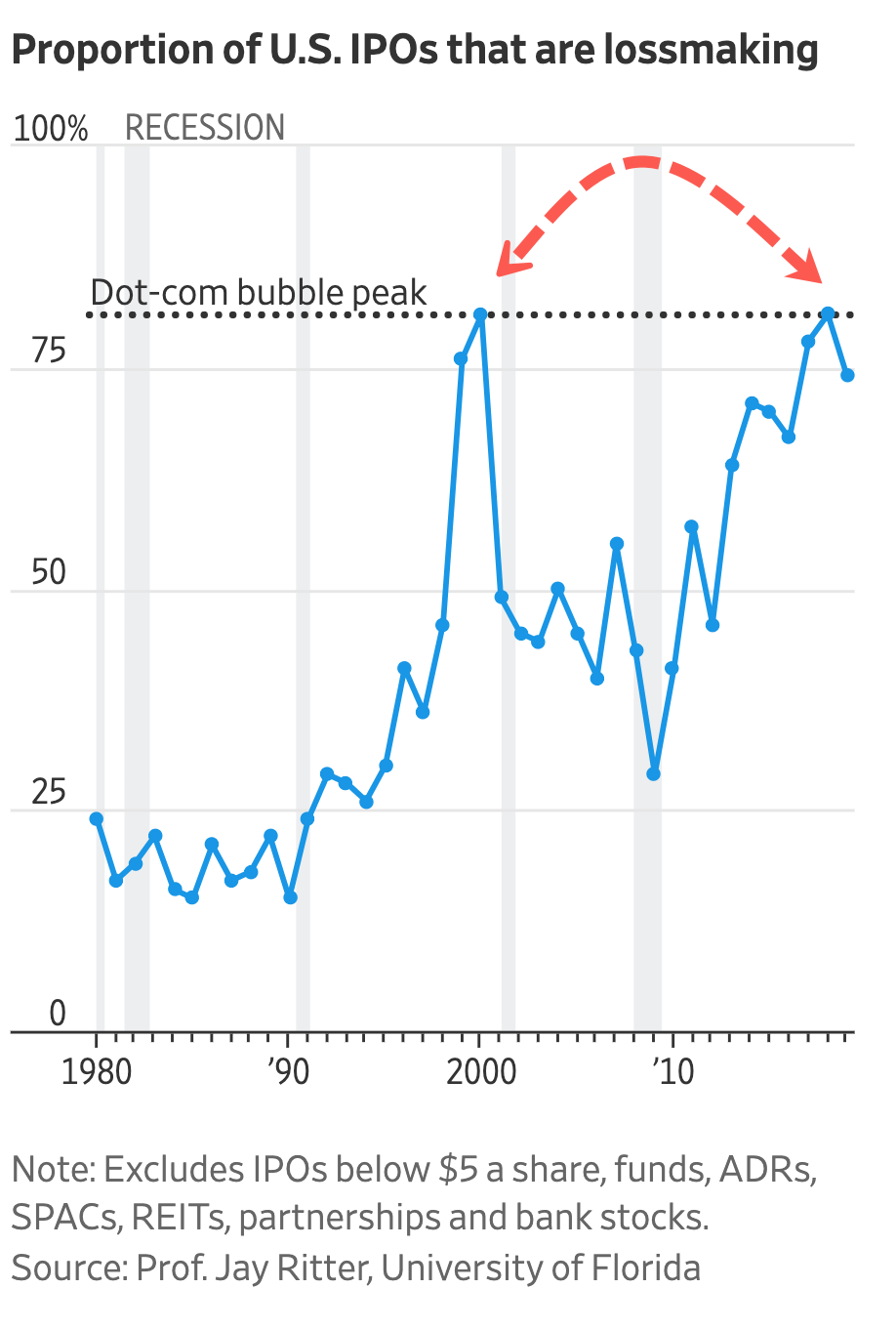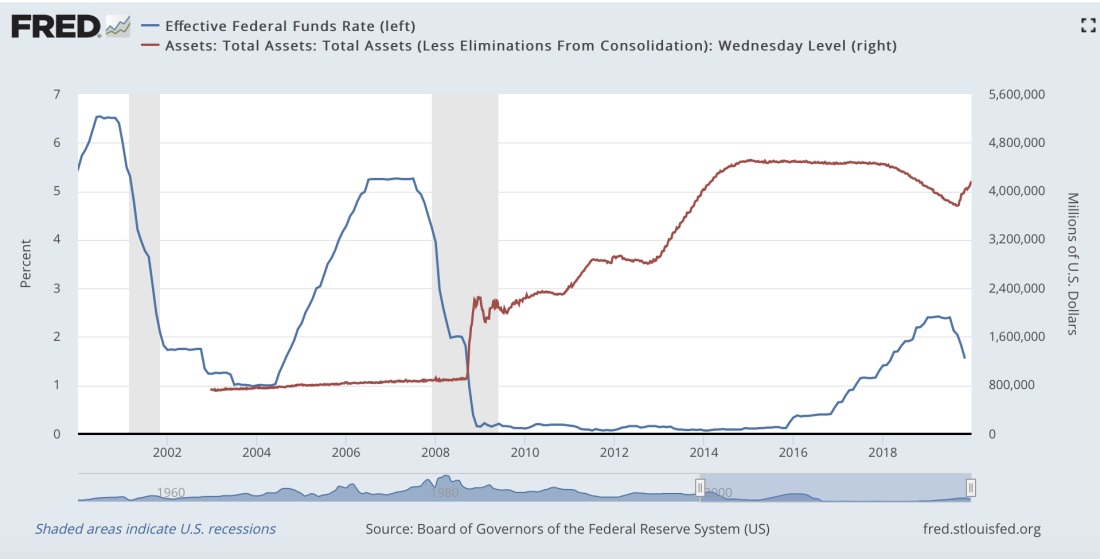The Dawn of the Dead on Wall Street
It’s like Dawn of the Dead on Wall Street. Zombies are everywhere.
Even as stocks continue to push to new highs, the number of money-losing companies listed on US stock markets has ballooned to levels not seen since the dot-com bubble of the late 1990s.
According to a recent Wall Street Journal article, nearly 40% of US-listed companies are losing money.
According to the Wall Street Journal, 42% of money-losing companies are in the healthcare sector, “reflecting the popularity of small, often loss-making biotech stocks.” Another 17% are tech companies, “many of them fashionable new ventures.”
When you look at IPOs, the situation is equally disturbing. According to a chart provided by University of Florida finance professor Jay Ritter, the percentage of money-losing IPOs hit 81% in 2018, equaling the level in 2000 at the height of the dot-com bubble.

Last fall, we reported on the “plight of the unicorns.” These are privately held companies valued over $1 billion. Speculative money pouted into companies like Lyft, Chewie, Uber and WeWork. Their IPOs were much-anticipated by investors. They are also the poster children for easy-money induced market mania, and their IPOs were crucial for maintaining the bubble.
Markets seemed to really wake up to the plight of the unicorn when WeWork aborted its much-anticipated IPO, but the air started coming out of the unicorn bubble long before WeWork’s IPO demise.
There are some eerie similarities between the height of dot-com mania and today.
And what is the common denominator between then and now?
Easy money courtesy of the Federal Reserve.

The dot-com and unicorn bubbles were both made possible by Fed policy that kept interest rates artificially low and allowed companies to leverage up and operate for years without making a profit. Speculative money flowed into these companies. Stock prices mushroomed.
But bubbles burst – as the dot-com bubble did in grand fashion.
Peter Schiff called the current batch of unicorn companies weak links in the chain. The weak links break first and the rest of the chain follows.
If investors are no longer willing to finance money-losing companies, if that type of speculative fervor has come to an end, this is a huge bell ringing on Wall Street, and it has massive implications, not only for the stock market, but for the overall economy.”
In a nutshell, these companies never bothered with making a profit. They were focused on the IPO. The strategy was to cash out on the backs of stock market investors who didn’t care whether or not the company was making money. They sacrificed profitability to deliver value to the customer in order to create a “sexy” story.
This wouldn’t be possible without the Federal Reserve artificially pushing interest rates down and injecting billions of liquidity into the markets. And it’s not just unicorns benefitting from the influx of easy money. As the WSJ article shows, established companies are also reaping a short-term windfall on Wall Street.
Tesla is the poster-child for money-losing companies with high stock valuations. As the WSJ put it, “Tesla shows a desire by investors to back disruptive companies as they build their sales.”
A ZeroHedge article summed up what has happened citing Tesla as an example.
It’s absolutely stunning how the Fed/ECB/BoJ injected upwards of $1.1 trillion into global markets in the last quarter and cut rates 80 times in the past 12 months, which allowed money-losing companies to survive another day.”
The ZeroHedge article called Telsa “the leader of this insanity, noting that it ranks as the biggest money-losing company on Wall Street. According to the report, the company’s stock value has soared 120% since the Fed launched ‘Not QE.’
Tesla investors are convinced that fundamentals are driving the stock higher, but that might not be the case, as central bank liquidity has been pouring into anything with a CUSIP.”
Then there are companies like GE struggling to turn a profit from traditional businesses. The WSJ called it a “dash for trash” on Wall Street, with GE being a prime beneficiary.
Not only GE, but previously unloved loss-making stocks more generally have made back some of their previous price falls.”
Again, where did all this malinvestment come from? Schiff summed it up.
Artificially low interest rates, cheap money sloshing around causing non-economically viable businesses to exist and to thrive.”





 Since Nayib Bukele became president of El Salvador, El Salvador has been in American media and global political discussion more than ever. While much of the attention focuses on Bukele’s mass incarceration of gang members and a decline in homicide of over 70%, Bukele has also drawn attention to his favoritism towards Bitcoin and how he […]
Since Nayib Bukele became president of El Salvador, El Salvador has been in American media and global political discussion more than ever. While much of the attention focuses on Bukele’s mass incarceration of gang members and a decline in homicide of over 70%, Bukele has also drawn attention to his favoritism towards Bitcoin and how he […] With gold hitting yet another awe-inspiring all-time high in the wake of Powell’s remarks reassuring markets (more or less) to expect rate cuts in 2024, a few analysts are pointing out risk factors for a correction — so is there really still room to run?
With gold hitting yet another awe-inspiring all-time high in the wake of Powell’s remarks reassuring markets (more or less) to expect rate cuts in 2024, a few analysts are pointing out risk factors for a correction — so is there really still room to run? Gold hit a new all-time nominal high, surpassing the previous record set in December of the previous year. The precious metal’s price reached approximately $2,140, indicating a robust and continuing interest in gold as a safe-haven asset, despite a rather peculiar lack of fanfare from the media and retail investors. This latest peak in gold […]
Gold hit a new all-time nominal high, surpassing the previous record set in December of the previous year. The precious metal’s price reached approximately $2,140, indicating a robust and continuing interest in gold as a safe-haven asset, despite a rather peculiar lack of fanfare from the media and retail investors. This latest peak in gold […] The gold price has been surging, with unprecedented central bank demand gobbling up supply. It has been a force to behold — especially as US monetary policy has been relatively tight since 2022, and 10-year Treasury yields have rocketed up, which generally puts firm downward pressure on gold against USD.
The gold price has been surging, with unprecedented central bank demand gobbling up supply. It has been a force to behold — especially as US monetary policy has been relatively tight since 2022, and 10-year Treasury yields have rocketed up, which generally puts firm downward pressure on gold against USD.  Total gold demand hit an all-time high in 2023, according to a recent report released by the World Gold Council. Last week, the World Gold Council (WGC) released its Gold Demand Trends report, which tracks developments in the demand for and use of gold around the world. Excluding over-the-counter (OTC) trade, 2023 gold demand fell slightly from 2022 […]
Total gold demand hit an all-time high in 2023, according to a recent report released by the World Gold Council. Last week, the World Gold Council (WGC) released its Gold Demand Trends report, which tracks developments in the demand for and use of gold around the world. Excluding over-the-counter (OTC) trade, 2023 gold demand fell slightly from 2022 […]